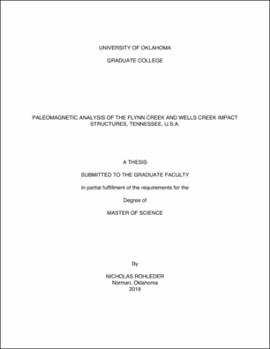| dc.description.abstract | The Flynn Creek impact structure consists of a 3.8-km circular feature that
contains deformed Ordovician through Devonian limestones and dolomites. The age of
this structure is stratigraphically constrained by the Ordovician Knox Group and the
overlying undeformed late Devonian through Mississippian Chattanooga Shale.
Paleomagnetic samples were collected from deformed Flynn Creek Breccia, a fallback
breccia from the inside of the structure. Stepwise thermal demagnetization and
alternating field demagnetization of tilted limestone samples reveals a characteristic
remanent magnetization (ChRM) with southeasterly declinations and moderate down
inclinations, with maximum unblocking temperatures of 440°C—the ChRM resides in
magnetite. The calculated pole position is 36.7°N, 131.3°E (dp = 5.8°, dm = 11.5°) which
lies on the late Carboniferous to early Permian portion of the apparent polar wander
path (APWP) for North America.
The Wells Creek impact structure consists of a 12-km circular feature that
contains deformed Ordovician through Mississippian limestones and dolomites. The
age of this structure is stratigraphically constrained by the Ordovician Knox Group and
the overlaying undeformed Cretaceous Tuscaloosa Gravel (200Ma +/- 100Ma).
Paleomagnetic samples were collected from deformed Fort Payne Limestone and
Warsaw Limestone, fallback breccias from the southern rim of the structure. Stepwise
thermal demagnetization and alternating field demagnetization of tilted limestone
samples reveals a ChRM with southeasterly declinations and moderate down
inclinations (declination = 152°, inclination = 18.5°, k = 105.7, and a95 = 6.5), with
maximum unblocking temperatures of 440°C—the ChRM resides in magnetite. The pole
lies at 37.1°N, 127.9°E (dp = 3.5°, dm = 6.8°) which lies on the late Carboniferous to
early Permian portion of the apparent polar wander path (APWP) for North America.
The ChRM that resides in both of these structures was imparted from the same
origin and is the result of a regional remagnetization event associated with the
Alleghenian Orogeny. The age of the Flynn Creek impact structure was not further
constrained through paleomagnetic tests; although the Wells Creek impact structure
now has an upper constraint at the late Carboniferous to early Permian. The ChRM is
interpreted as a chemical remanent magnetization (CRM) imparted by the influx of
heated orogenic brines into these structures and is carried in secondary magnetite
formed by alteration of pyrite. Although there are other possible mechanisms for
remagnetization, the lack of deep burial and evidence of alteration in petrographic study
indicate that this magnetization was the result of hydrothermal fluid activity. | en_US |
